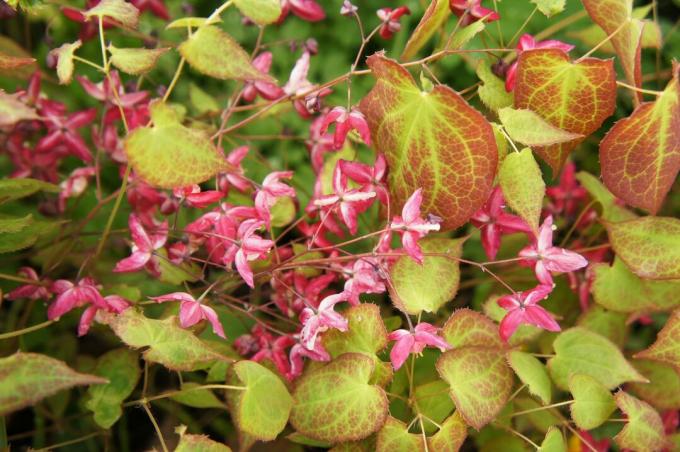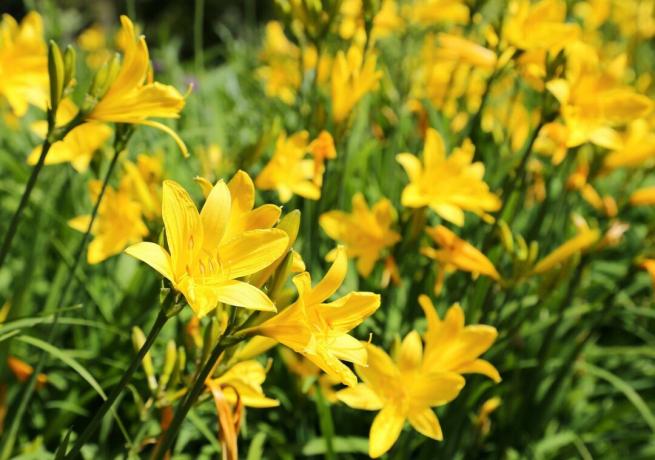Of course, everyone can plant their garden as they wish, but there are a few tricks that make life easier. We provide assistance.

A garden should actually be a place of rest and relaxation - but many gardeners associate it with a lot of work and effort instead of just letting their soul dangle. Mowing the lawn, trimming the hedge, and pulling weeds are chores for many that, while tedious, seem inevitable. This leaves little time to enjoy the beauty of your own garden. But that doesn't have to be the case: if you follow a few tips and tricks when planting your garden, you can make your garden easy to care for without losing its attractiveness. You can find our best tips here.
contents
-
plant garden
- 1. Note the ground conditions
- 2. Plant ground cover
- 3. Wildflower meadow instead of English lawn
- 4. Perennials instead of summer flowers
- 5. Easy-care tree species
- 6. Easy care roses
- 7. Easy-care privacy screen
- 8. raised beds
plant garden
Designing a low-maintenance garden is not that difficult. In fact, if you follow this advice when you plant, you can save yourself a lot of trouble.
1. Note the ground conditions
A problem that many gardeners are often unaware of is that their plants don't suit their garden. In fact, the decision when choosing a plant is often based on visual criteria - the soil requirements of the desired plant are only rarely taken into account. But if you don't choose your plants to suit their location in the garden, you end up doing more work than necessary: such plants often need significantly more fertilizer and water than suitable greenery. Therefore, pay attention to the soil structure in your garden and look for plants that are particularly well suited for this location. Rock garden plants are much better off in a dry, sunny location than forest or moor plants. In addition, you should rely on native plant species, as these are often more robust and require less care than exotic ones.
2. Plant ground cover
Pulling weeds is one of the most unpopular tasks in gardening. Fortunately, there is a very simple trick that not only reduces annoying weeds, but also looks good: so-called ground cover, i.e. plants that grow herbaceously and densely but close to the ground, are perfect for the low-maintenance garden. Not only do they reliably suppress weeds, they also protect the soil from erosion and reduce the evaporation of water, so less watering is required. In addition, ground cover can also score points visually - especially flowering ground cover plants like these elf flower (epimedium) quickly attract envious looks.

An equally effective alternative to ground cover is covering gaps with mulch. Pine bark mulch, like ours, is particularly decorative Plantura organic pine bark. This is sustainably manufactured in the EU and, with its coarse structure and natural coloring, ensures an aesthetic bed design. Just like ground cover, mulch also protects the soil from erosion, drying out and weed growth and is a real eye-catcher.

Plantura organic pine bark
Decorative & natural pine bark
in coarse structure from 25 to 40 mm,
protects against weed growth and dehydration
3. Wildflower meadow instead of English lawn
Lawns are particularly common in larger gardens and usually serve as a place to play, romp and relax. Unfortunately, a well-kept lawn also causes a lot of work, because regular lawn fertilizing, mowing and scarify are mandatory if the lawn is to remain beautiful for a long time. As an alternative, many people only think of a gravel bed or another paved area - these are easy to care for, but neither particularly beautiful nor environmentally friendly. Wildflower meadows, on the other hand, are easy to care for and ecologically valuable. These only have to be mowed once in June so that they bloom in their old glory next year.
4. Perennials instead of summer flowers
marigold (Calendula officinalis), begonias (Begonia semperflorens) and fuchsias (fuchsia) have a permanent place in many gardens and are a real ornament with their pretty flowers. Unfortunately, the impressive flowers are anything but easy to care for, because as annual plants they have to be replanted every year and watered particularly intensively in dry periods. Robust and yet beautiful are hardy perennials - due to their roots, which go much deeper into the Digging in the ground than those of summer flowers, they can withstand drought better and are therefore distinct easier to care for. But you don't have to do without radiant flowers: lady's mantle (Alchemilla), forest aster (Eurybia divaricata) and daylilies (Hemerocallis) enchant with their great flowers and their robust nature.

5. Easy-care tree species
Trees should not be missing in any garden, after all they are not only extremely decorative, but also provide important shade. But the care of many deciduous trees is difficult for most people - regular topiary in particular takes time and nerves and has caused many an accident. Nevertheless, you don't have to do without trees in the garden: Japanese maple (Acer palmatum), ornamental cherry (prunus) and witch hazel (witch hazel) belong, for example, to the ornamental trees that can cope wonderfully without pruning. Also sphericaltrumpet tree (catalpa ‘Nana’) and spherical black locust (Robinia ‘Umbraculifera’) keep their rounded crown without being trimmed. If you want to snack without pruning, the service pear is a good choice.
6. Easy care roses
For many may roses (pink) are not missing in the garden, after all, the "Queen of Flowers" has an unmistakable charm. Unfortunately, the majestic plant also needs a lot of attention so that it can thrive optimally. However, they are easier to care for wild roses: These require neither regular pruning nor fertilizer and are considered to be particularly robust. Nevertheless, they trump with their charming flowers and even deliver delicious ones in autumn rosehips. If you still prefer a breeding rose, you should pay particular attention to properties such as robustness and self-cleaning when choosing a variety.

7. Easy-care privacy screen
Nobody likes prying eyes in the garden. This makes it all the more important for many garden owners to have a privacy screen that is not only easy to care for, but above all opaque. It is better not to rely on wood - it may look nice, but wooden fences need regular care in order not to become green and unsightly in the long term or even to rot. Powder-coated aluminum or hot-dip galvanized steel are more suitable here, as these are almost indestructible even without care. If you prefer to work with hedges and still want to have a low-maintenance garden, you should instead click on typical topiary concentrate on flowering wild shrubs, they need much less Care. Also bamboo (Bamboooideae) is well suited as an easy-care privacy screen, but you should pay attention to a so-called rhizome barrier when planting - otherwise the plant will quickly spread uncontrollably.
Further easy-care hedges see this article.
8. raised beds
If you want to eat fresh vegetables from your own cultivation, you will quickly realize that this requires a certain amount of effort. But with a little planning, you can also make the vegetable patch as easy to care for as possible. Raised beds in particular are perfect for low-maintenance gardens. Even if constructing and laying out the raised bed is a bit more complex than with normal beds, it is worth the purchase anyway - fewer weeds, less snail infestation and less fertilizer are just a few advantages that the raised bed has to offer to have. The fact that many raised beds are easy to winterize also suggests that this form of vegetable cultivation is ideal for the garden.
10 tips for the perfect raised bed for your garden can be found here.
...and receive concentrated plant knowledge and inspiration directly in your e-mail inbox every Sunday!



